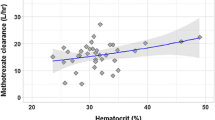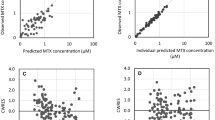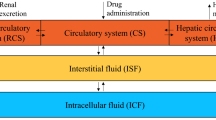Abstract
Background
Methotrexate is the most efficient anticancer drug in osteosarcoma. It requires individual exposure monitoring because of the high doses used, its wide interpatient pharmacokinetic variability and the existence of demonstrated relationships between efficacy, toxicity and serum drug concentrations.
Objective
To develop a maximum a posteriori (MAP) Bayesian estimator able to predict individual pharmacokinetic parameters and exposure indices such as area under the curve (AUC) for methotrexate from a few blood samples, in order to prevent toxicity and facilitate further studies of the relationships between efficacy and exposure.
Methods
Methotrexate population pharmacokinetics were estimated by a retrospective analysis of concentration data from 40 children and young adults by using the nonparametric expectation maximisation method NPEM. A linear two-compartment model with elimination from the central compartment was assumed. Individual pharmacokinetic parameters and AUC were subsequently estimated in 30 other young patients, using MAP Bayesian estimation as implemented in two programs, ADAPT II and an inhouse program Winphar®.
Results
The pharmacokinetic parameters used in the model were the volume of the central compartment (V1) and the transfer constants (k10, k12 and k21). The mean values (with percentage coefficient of variation) obtained were: 18.24L (54.1%) and 0.41 (42.3%), 0.0168 (68.7%), and 0.1069 (61.3%) h-1, respectively. Bayesian forecasting enabled nonbiased estimation of AUC and systemic clearance using a schedule with two sampling times (6 and 24 hours after the beginning of the infusion) and either program. Collection of a third sample at 4 hours improved the precision.
Conclusion
The Bayesian adaptive method developed herein allows accurate estimation of individual exposure to methotrexate and can easily be used in clinical practice.








Similar content being viewed by others
References
Masson E, Relling MV, Synold TW, et al. Accumulation of methotrexatepolyglutamates in lymphoblasts is a determinant of antileukemic effects in vivo. J Clin Invest 1996; 97: 73–80
Goldie JH, Price LA, Harrap KR. Methotrexate toxicity: correlation with duration of administration: plasma levels, dose and excretion pattern. Eur J Cancer 1972; 8: 409–14
Stoller RG, Hande KR, Jacobs SA, et al. Use of plasma pharmacokinetics to predict and prevent methotrexate toxicity. N Engl J Med 1977; 297: 630–4
Evans WE, Pratt C, Taylor RH, et al. Pharmacokinetic monitoring of high-dose methotrexate: early recognition of high-risk patients. Cancer Chemother Pharmacol 1979; 3: 161–6
Evans WE, Relling MV, Rodman JH, et al. Conventional compared with individualized chemotherapy for childhood acute lymphoblastic leukemia. N Engl J Med 1998; 338: 499–505
Evans WE, Crom WR, Abromowitch M, et al. Clinical pharmacodynamics of high-dose methotrexate in acute lymphocytic leukemia. N Engl J Med 1986; 314: 471–7
Delepine N, Delepine G, Bacci G, et al. Influence of methotrexate dose intensity on outcome of patients with high grade osteogenic osteosarcoma: analysis of the literature. Cancer 1996; 78: 2127–35
Delepine N, Delepine G, Jasmin C, et al. Importance of age and methotrexate dosage: prognosis in children and young adults with high-grade osteosarcomas. Biomed Pharmacother 1988; 42: 257–62
Delepine N, Delepine G, Cornille H, et al. Dose escalation with pharmacokinetics monitoring in methotrexate chemotherapy of osteosarcoma. Anticancer Res 1995; 15: 489–94
Graf N, Winkler K, Betlemovic M, et al. Methotrexate pharmacokinetics and prognosis in osteosarcoma. J Clin Oncol 1994; 12: 1443–51
Bacci G, Ferrari S, Delepine N, et al. Predictive factors of his-tologic response to primary chemotherapy in osteosarcoma of the extremity: study of 272 patients preoperatively treated with high-dose methotrexate, doxorubicin, and cisplatin. J Clin Oncol 1998; 16: 658–63
Rosen G, Marcove RC, Caparros B, et al. Primary osteogenic sarcoma: the rationale for preoperative chemotherapy and delayed surgery. Cancer 1979; 43: 2163–77
Rosen G, Caparros B, Huvos A, et al. Preoperative chemotherapy for osteogenic sarcoma: selection of postoperative adjuvant chemotherapy based on the response of the primary tumor to preoperative chemotherapy. Cancer 1982; 49: 1221–30
Winkler K, Beron G, Koltz R, et al. Neoadjuvant chemotherapy for osteogenic sarcoma: results of a cooperative German/Austrian study. J Clin Oncol 1984; 2: 617–24
Sabot C, Debord J, Roullet B, et al. Bayesian estimation and population pharmacokinetic parameters of high dose methotrexate in osteosarcoma. Clin Res Reg Affairs 1993; 10: 233–41
Pignon T, Lacarelle B, Duffaud F, et al. Pharmacokinetic of high-dose methotrexate in adult osteogenic sarcoma. Cancer Chemother Pharmacol 1994; 33: 420–4
Sabot C, Debord J, Roullet B, et al. Comparison of 2- and 3-compartment models for the Bayesian estimation of methotrexate pharmacokinetics. Int J Clin Pharmacol Ther 1995; 33: 164–9
Sabot C, Marquet P, Debord J, et al. Bayesian pharmacokinetic estimation of vinorelbine in non-small-cell lung cancer patients. Eur J Pharmacol 1998; 54: 171–5
D’Argenio DZ, Schumitzky A. ADAPT II user’s guide. University of Southern California, Los Angeles (CA): Biomedical Simulations Resource, 1990
Delepine N, Desbois JC, Delepine G, et al. Individualization of the dosage of high-dose methotrexate by assaying plasma concentration: therapeutic value in osteogenic sarcoma. Bull Cancer 1989; 76: 913–8
Raude E, Oellerich M, Weinel P, et al. High dose methotrexate: pharmacokinetics in children and young adults. Int J Clin Pharmacol Ther 1988; 26: 364–70
Jelliffe RW, Schumitzky A, Bayard D, et al. Model-based, goal oriented individualized drug therapy. Clin Pharmacokinet 1998; 34: 57–77
Jelliffe R, Bayard D, Milman M, et al. Achieving target goals most precisely using nonparametric compartmental models and ‘multiple model’ design of dosage regimens. Ther Drug Monit 2000; 22: 346–53
Sheiner LB, Beal SL. Some suggestions for measuring predictive performance. J Pharmacokinet Biopharm 1981; 9: 503–12
Bellissant E, Sebille V, Paintaud G. Methodological issues in pharmacokinetic-pharmacodynamic modelling. Clin Pharmacokinet 1998; 35: 151–66
Rousseau A, Marquet P, Debord J. Adaptive control methods for the dose individualisation of anticancer agents. Clin Pharmacokinet 2000; 38: 315–63
Odoul F, Le Guellec C, Lamagnere JP, et al. Prediction of methotrexate elimination after high-dose infusion in children with acute lymphoblastic leukemia using a population pharmacokinetic approach. Fundam Clin Pharmacol 1999; 13: 595–604
Borsi JD, Moe PJ. Systemic clearance of methotrexate in the prognosis of acute lymphoblastic leukemia in children. Cancer 1987; 60: 3020–4
Donelli MG, Zucchetti M, Robatto A, et al. Pharmacokinetics of HD-MTX in infants, children, and adolescents with non-B acute lymphoblastic leukemia. Med Pediatr Oncol 1995; 24: 154–9
Acknowledgements
This study was supported by a grant from Limoges University, France.
Author information
Authors and Affiliations
Corresponding author
Rights and permissions
About this article
Cite this article
Rousseau, A., Sabot, C., Delepine, N. et al. Bayesian Estimation of Methotrexate Pharmacokinetic Parameters and Area Under the Curve in Children and Young Adults with Localised Osteosarcoma. Clin Pharmacokinet 41, 1095–1104 (2002). https://doi.org/10.2165/00003088-200241130-00006
Published:
Issue Date:
DOI: https://doi.org/10.2165/00003088-200241130-00006




